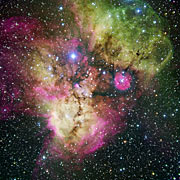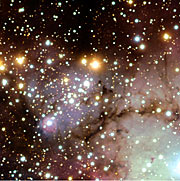Tisková zpráva
The Cosmic Christmas Ghost
Two Stunning Pictures of Young Stellar Clusters
25. prosince 2005
Just like Charles Dickens' Christmas Carol takes us on a journey into past, present and future in the time of only one Christmas Eve, two of ESO' s telescopes captured various stages in the life of a star in a single image.
Image eso0544a shows the area surrounding the stellar cluster NGC 2467, located in the southern constellation of Puppis (" The Stern"). With an age of a few million years at most, it is a very active stellar nursery, where new stars are born continuously from large clouds of dust and gas.
The image, looking like a colourful cosmic ghost or a gigantic celestial Mandrill [1], contains the open clusters Haffner 18 (centre) and Haffner 19 (middle right: it is located inside the smaller pink region - the lower eye of the Mandrill), as well as vast areas of ionised gas.
The bright star at the centre of the largest pink region on the bottom of the image is HD 64315, a massive young star that is helping shaping the structure of the whole nebular region.
Image eso0544a was taken with the Wide-Field Imager camera at the 2.2m MPG/ESO telescope located at La Silla, in Chile.
Another image of the central part of this area is shown as image eso0544b. It was obtained with the FORS2 instrument at ESO' s Very Large Telescope on Cerro Paranal, also in Chile.
Image eso0544b zooms in on the open stellar cluster Haffner 18, perfectly illustrating three different stages of this process of star formation: In the centre of the picture, Haffner 18, a group of mature stars that have already dispersed their birth nebulae, represents the completed product or immediate past of the star formation process. Located at the bottom left of this cluster, a very young star, just come into existence and, still surrounded by its birth cocoon of gas, provides insight into the very present of star birth. Finally, the dust clouds towards the right corner of the image are active stellar nurseries that will produce more new stars in the future.
Haffner 18 contains about 50 stars, among which several short lived, massive ones. The massive star still surrounded by a small, dense shell of hydrogen, has the rather cryptic name of FM3060a. The shell is about 2.5 light-years wide and expands at a speed of 20 km/s. It must have been created some 40,000 years ago. The cluster is between 25,000 and 30,000 light-years away from us [2].
Poznámky
[1] NGC 2467 is also sometimes referred as the " Skull and Crossbones".
[2] A study of the cluster Haffner 18 is presented in Moreno-Corral et al. (2005), Rev. Mex. A& A 41, 69 and in Munari et al. (1998), MNRAS 297, 867.
Další informace
Technical information:
Image eso0544a is based on images obtained with the WFI instrument on the ESO/MPG 2.2-m telescope for Rubio/Minniti/Barba/Mendez on December, 2003. The 49 observations were done in six different filters : U (2 hour exposure), B, O III, V, H-alpha and R (1 hour exposure each). The data were extracted from the ESO Science Archive. The raw observations were reduced and combined by Benoî t Vandame (ESO). North is right and East is to the top. The field of view is about 30x30 arcmin. Image eso0544b is a colour-composite image obtained with the FORS2 multi-mode instrument on Kueyen, the second Unit Telescope of the Very Large Telescope. The data was collected during the commissioning of the instrument in February 2000, through 4 filters: B, V, R and I, for a total exposure time of only 11 minutes. The observations were extracted from the ESO Science Archive and reduced by Henri Boffin (ESO). North is above and East is to the left. Final processing of the images was done by Kristina Boneva and Haennes Heyer (ESO).
O zprávě
| Tiskové zpráva č.: | eso0544 |
| Legacy ID: | Photo 42a-b/05 |
| Jméno: | Haffner 18, Haffner 19, NGC 2467 |
| Typ: | Milky Way : Nebula : Type : Star Formation |
| Facility: | MPG/ESO 2.2-metre telescope |
| Instruments: | WFI |
Our use of Cookies
We use cookies that are essential for accessing our websites and using our services. We also use cookies to analyse, measure and improve our websites’ performance, to enable content sharing via social media and to display media content hosted on third-party platforms.
ESO Cookies Policy
The European Organisation for Astronomical Research in the Southern Hemisphere (ESO) is the pre-eminent intergovernmental science and technology organisation in astronomy. It carries out an ambitious programme focused on the design, construction and operation of powerful ground-based observing facilities for astronomy.
This Cookies Policy is intended to provide clarity by outlining the cookies used on the ESO public websites, their functions, the options you have for controlling them, and the ways you can contact us for additional details.
What are cookies?
Cookies are small pieces of data stored on your device by websites you visit. They serve various purposes, such as remembering login credentials and preferences and enhance your browsing experience.
Categories of cookies we use
Essential cookies (always active): These cookies are strictly necessary for the proper functioning of our website. Without these cookies, the website cannot operate correctly, and certain services, such as logging in or accessing secure areas, may not be available; because they are essential for the website’s operation, they cannot be disabled.
Functional Cookies: These cookies enhance your browsing experience by enabling additional features and personalization, such as remembering your preferences and settings. While not strictly necessary for the website to function, they improve usability and convenience; these cookies are only placed if you provide your consent.
Analytics cookies: These cookies collect information about how visitors interact with our website, such as which pages are visited most often and how users navigate the site. This data helps us improve website performance, optimize content, and enhance the user experience; these cookies are only placed if you provide your consent. We use the following analytics cookies.
Matomo Cookies:
This website uses Matomo (formerly Piwik), an open source software which enables the statistical analysis of website visits. Matomo uses cookies (text files) which are saved on your computer and which allow us to analyze how you use our website. The website user information generated by the cookies will only be saved on the servers of our IT Department. We use this information to analyze www.eso.org visits and to prepare reports on website activities. These data will not be disclosed to third parties.
On behalf of ESO, Matomo will use this information for the purpose of evaluating your use of the website, compiling reports on website activity and providing other services relating to website activity and internet usage.
Matomo cookies settings:
Additional Third-party cookies on ESO websites: some of our pages display content from external providers, e.g. YouTube.
Such third-party services are outside of ESO control and may, at any time, change their terms of service, use of cookies, etc.
YouTube: Some videos on the ESO website are embedded from ESO’s official YouTube channel. We have enabled YouTube’s privacy-enhanced mode, meaning that no cookies are set unless the user actively clicks on the video to play it. Additionally, in this mode, YouTube does not store any personally identifiable cookie data for embedded video playbacks. For more details, please refer to YouTube’s embedding videos information page.
Cookies can also be classified based on the following elements.
Regarding the domain, there are:
- First-party cookies, set by the website you are currently visiting. They are stored by the same domain that you are browsing and are used to enhance your experience on that site;
- Third-party cookies, set by a domain other than the one you are currently visiting.
As for their duration, cookies can be:
- Browser-session cookies, which are deleted when the user closes the browser;
- Stored cookies, which stay on the user's device for a predetermined period of time.
How to manage cookies
Cookie settings: You can modify your cookie choices for the ESO webpages at any time by clicking on the link Cookie settings at the bottom of any page.
In your browser: If you wish to delete cookies or instruct your browser to delete or block cookies by default, please visit the help pages of your browser:
Please be aware that if you delete or decline cookies, certain functionalities of our website may be not be available and your browsing experience may be affected.
You can set most browsers to prevent any cookies being placed on your device, but you may then have to manually adjust some preferences every time you visit a site/page. And some services and functionalities may not work properly at all (e.g. profile logging-in, shop check out).
Updates to the ESO Cookies Policy
The ESO Cookies Policy may be subject to future updates, which will be made available on this page.
Additional information
For any queries related to cookies, please contact: pdprATesoDOTorg.
As ESO public webpages are managed by our Department of Communication, your questions will be dealt with the support of the said Department.


